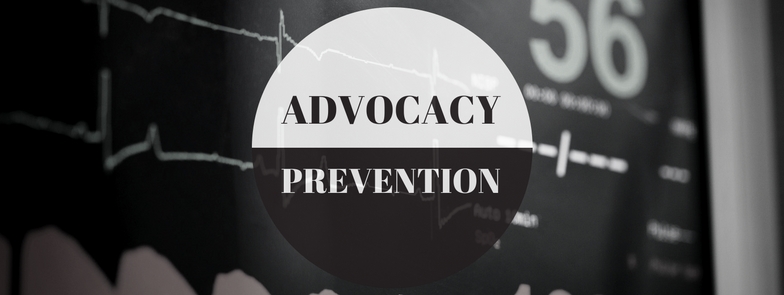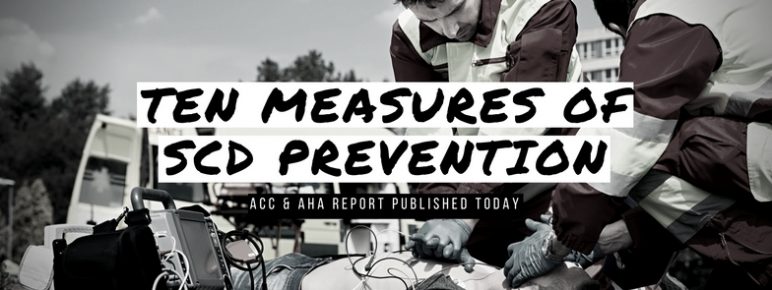A new joint report released today by the American College of Cardiology (ACC) and the American Heart Association (AHA) offers practitioners and stakeholders ten evidence-based quality and performance measures to prevent sudden cardiac death (SCD).
"This is the first comprehensive measure set in the area of SCD prevention," says Sana Al-Khatib, MD, co-chair of the report writing committee in an ACC press release. "Our vision is that these measures will be developed, tested and implemented in clinical practice and that implementation will improve patient care and outcomes."
Sudden cardiac death a "healthcare crisis"
The American Heart Association reports more than 350,000 out-of-hospital cardiac arrests (OHCA) occurring in 2016 with only 12 percent of people surviving to hospital discharge. These approximate statistics suggest more than 308,000 sudden cardiac deaths per year.
The Sudden Cardiac Arrest Foundation argues that sudden cardiac arrest is a "healthcare crisis" with the number of deaths each year "roughly equivalent to the number who die from Alzheimers disease, assault with firearms, breast cancer, cervical cancer, colorectal cancer, diabetes, HIV, house fires, motor vehicle accidents, prostate cancer and suicides combined."
Not enough has been done to combat this crisis, suggests the ACC press release, describing a prevalent "under-utilization" of interventions, treatments and device therapies for at-risk patients. "Many of the sudden deaths occurring in the U.S. may be prevented by implementing some evidence-based and guideline-endorsed recommendations for primary or secondary prevention of SCD," reads the release.
Ten measures of quality SCD prevention
The joint committee authoring the report aimed to identify measures to assess quality of care for SCD prevention, which involves a dual-aim. "We need initiatives to improve the quality of care for those with a known risk, but also for the victims of sudden cardiac arrest," said Doctor Al-Khatib in an AHA press release.
The committee identified ten measures across four categories:
Preventive cardiology measures
- Smoking cessation intervention in patients who suffered sudden cardiac arrest, have a life-threatening ventricular arrhythmia, or are at risk for SCD
"Clinicians should provide explicit documentation that all adults who use tobacco have received a smoking cessation intervention, which may include counseling (such as a verbal recommendation to quit or referral to a smoking cessation program or counselor) and pharmacological therapy," reads the report. "[Electronic health record] prompts have been demonstrated to increase tobacco counseling and referral for treatment."
- Screening for family history of SCD
- Screening for asymptomatic left ventricular dysfunction among individuals who have a strong family history of cardiomyopathy and SCD
A ROLE FOR ECHO: "The writing committee considered a quality measure in which cardiac imaging (generally echocardiogram) is used to screen for asymptomatic left ventricular dysfunction (LVD) in individuals with a strong family history of an inherited disorder associated with SCD," reads the report. "It is reasonable to screen with echocardiography family members of individuals who had those conditions and had SCD."
Measures below include the use of guideline-directed medical therapy for patients with LVD and symptomatic heart failure, and for patients with LVD caused by a prior cardiac arrest.
Resuscitation & emergency care measures
- Referring for CPR and AED education those family members of patients who are hospitalized with known heart conditions that increase the risk of sudden cardiac arrest
"Given that bystander CPR is lifesaving in many patients and that the majority of SCD or SCA does not occur in public locations, people who are likely to witness such an event in a family member who is at an increased risk of SCA should be trained in how to recognize and respond to it," reads the report.
Heart Failure & general cardiology measures
- Use of implantable cardioverter defibrillators (ICDs) for prevention of SCD in patients with heart failure and reduced ejection fraction who have an anticipated survival of more than one year
Studies on implantable cardioverter defibrillator implantation have shown a "significant survival benefit" absent contraindications, argue the authors. ICDs are a hot topic at Alliance of Cardiovascular Professionals regional cardio conferences—see our upcoming continuing education programs.
- Use of guideline-directed medical therapy (ACE-I or ARB or ARNI, beta-blocker, aldosterone receptor antagonist) for prevention of SCD in patients with heart failure and reduced ejection fraction
- Use of guideline-directed medical therapy (ACE-I or ARB or ARNI, beta-blocker, aldosterone receptor antagonist) for prevention of SCD in patients with heart attack and reduced ejection fraction
"Guideline-directed medical therapy has been shown to reduce the risk of SCD and/or all-cause death" in patients with left ventricular dysfunction (LVD) and symptomatic heart failure, and in patients with LVD caused by a prior myocardial infarction, reads the report.
Electrophysiology measures
- Documenting the absence of reversible causes of ventricular tachycardia or ventricular fibrillation cardiac arrest and/or sustained ventricular tachycardia before a secondary-prevention ICD is placed
"The present measure involves documenting that reversible causes were considered and excluded during the index event before a secondary-prevention ICD was implanted, because this allows for an evaluation of the appropriateness of the ICD," reads the report.
- Counseling eligible patients about an implantable cardioverter defibrillator (ICD)
"Given that this therapy is lifesaving in many patients, a performance measure that involves counseling about the potential benefits of primary-prevention ICDs in appropriately selected patients is important," reads the report. "For this measure to achieve its full potential, and in particular because of the clear disparities in utilization of ICD therapy, data on it will have to be stratified and reported by sex and race/ethnicity."
- Counseling first-degree relatives of survivors of sudden cardiac arrest associated with an inheritable condition about the need for screening for the inheritable condition
Notable omissions: genetics and athlete screening
"Genetics is one area where there are strong links between SCD and certain disorders, but evidence to support a Class I recommendation is lacking," reads an AHA "Top Ten Things to Know" resource. "SCD in athletes is a high-profile event, yet there are many challenges to screening athletes for SCA."

A call for advocacy
Authors outline a number of areas that require additional research, including the widespread adoption and evaluation of these ten measures as well as the assessment of potential advocacy initiatives to further SCD prevention.
While a 2008 study published in JAMA found that only 37 percent of out-of-hospital cardiac arrest events were witnessed by bystanders, and of those 84.8 percent received bystander CPR prior to the arrival of EMS providers, the latter rate continues to be identified as an area with room for improvement.
Authors of the today's report suggest that tracking legislation mandating high school student training in CPR and AED could be beneficial. "Provision of bystander CPR doubles survival after the onset of SCA... A large, community-based, randomized trial showed that training and equipping laypersons to recognize and respond to OHCA by providing CPR and applying an AED before arrival of EMS providers on scene increased survival as compared with providing CPR alone," write the authors. "Requiring training in these skills during high school will markedly increased the proportion of laypersons trained over time."
What do you think? Will these measures improve care of sudden cardiac death in your organization or region? Is advocacy required? Leave a comment!
